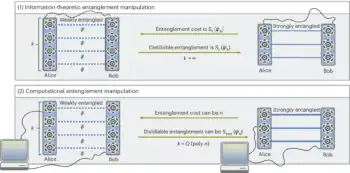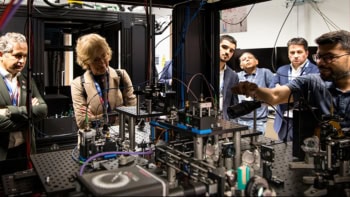
Physicists in the US have used two trapped atomic ions to create the first multiple-qubit programmable quantum computer. The device can be controlled to perform at least 160 different quantum computing operations. Its inventors claim that the device is an important step towards the development of a practical “universal quantum computer” that can be set to run any program allowed by quantum mechanics.
While classical computers store and process information as “bits” that can have one of two states – “0” or “1” – a quantum computer exploits the ability of quantum particles to be in the “superposition” of two or more states at the same time. Such a device could, in principle, outperform a classical computer on some tasks. In practice, however, physicists have struggled to create even the simplest quantum computers because the fragile nature of quantum bits – or qubits – makes them very difficult to transmit, store and process.
Earlier this year researchers at the National Institute of Standards and Technology (NIST) in Colorado unveiled a quantum processor that uses two beryllium ions as a pair of qubits – each of which can store information in two quantum states. The ions are trapped on a small ultracold chip using electric and magnetic fields. Ultraviolet laser pulses are used to store data by setting the quantum state of each qubit. Electric fields are then used to move the ions between different zones in the trap. In this way, the qubits can be moved around and made to interact with each other in 15 different ways – without losing their quantum nature 94% of the time.
All possible operations
Now, the NIST researchers, led by David Hanneke, have gone a step further and combined these 15 basic operations to perform 160 different quantum computing programs. The operations were chosen at random from the infinite number of ways that two qubits can be used to perform quantum calculations – but Hanneke claims that the set of 160 is large and diverse enough to represent all possible operations. As a result, he claims that the quantum processor is “universal”.
“It’s a step toward the big goal of doing calculations with lots and lots of qubits,” says Hanneke. “The idea is you’d have lots of these processors and you’d link them together,” he explained.
The quantum-computing processes that the chip executed included the “rotation” of the value of a single qubit – changing its value from “1” to a superposition of “1” and “0”, for example. The team was also able to “entangle” the two qubits. Entanglement means that the particles can have a much closer relationship than allowed by classical physics, something that could be exploited in a wide range of applications such as the massive parallel processing of information secure transmission of quantum-encrypted information.
The programs worked about 79% of the time, averaged over 900 runs. This figure will have to be boosted much nearer to 100% before it can be used in a practical quantum computer. In addition, physicists will have to work out ways of hooking up many such systems in order to perform large calculations.
The research is described in Nature Physics.



